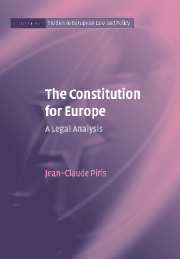Book contents
- Frontmatter
- Contents
- List of figures
- List of tables
- List of boxes
- Series editors' preface
- Acknowledgments
- Table of cases
- List of annexes
- Introduction
- 1 Is The constitution for Europe ‘dead and buried’?
- 2 The process that led to the Constitution
- 3 Changes in structures and procedures
- 4 Changes in the institutions
- 5 Changes in substance
- 6 General Assessment
- Conclusion what will the final form of the union be?
- List of annexes
- Table of equivalences between the provisions of the Treaty establishing a Constitution for Europe and the provisions of the EU and EC Treaties
- List of ‘passerelles’ and provisions on a simplified revision procedure
- Table of references
- Index
5 - Changes in substance
Published online by Cambridge University Press: 04 August 2010
- Frontmatter
- Contents
- List of figures
- List of tables
- List of boxes
- Series editors' preface
- Acknowledgments
- Table of cases
- List of annexes
- Introduction
- 1 Is The constitution for Europe ‘dead and buried’?
- 2 The process that led to the Constitution
- 3 Changes in structures and procedures
- 4 Changes in the institutions
- 5 Changes in substance
- 6 General Assessment
- Conclusion what will the final form of the union be?
- List of annexes
- Table of equivalences between the provisions of the Treaty establishing a Constitution for Europe and the provisions of the EU and EC Treaties
- List of ‘passerelles’ and provisions on a simplified revision procedure
- Table of references
- Index
Summary
The Constitution does not extend the Union's remit to substantive new areas of competences. Most importantly, and this is where the use of the name ‘Constitution’ might create some confusion, the Constitution is and remains a treaty and its ‘masters’ are still the Member States. They have kept for themselves the power to amend the Treaties or, as constitutional lawyers would say, the Kompetenz Kompetenz, the power for distributing competences. Like the present Treaties, the Constitution does not allow itself to be amended by a majority of Member States. It requires approval and ratification by each of them.
The Constitution begins with a short and entirely new Preamble which was drafted in the Convention. It states, in particular, that ‘the peoples of Europe are determined to transcend their former divisions and, united ever more closely, to forge a common destiny’. Thus, the wording ‘united ever more closely’ replaces the traditional formula of ‘an ever closer union’.
During the Convention and the IGC, some delegations argued that the Preamble should refer directly to God or to Europe's Christian heritage. Others opposed this, and the Preamble limits itself to mentioning ‘the cultural, religious and humanist inheritance of Europe’.
Contrary to the Treaties of Maastricht and Amsterdam, the Constitution confers only a few new competences of substance on the EU. To a large extent, the substantive content of the present EC Treaty remains the same. The few new competences conferred on the EU in the Constitution are far from being revolutionary.
- Type
- Chapter
- Information
- The Constitution for EuropeA Legal Analysis, pp. 131 - 178Publisher: Cambridge University PressPrint publication year: 2006

